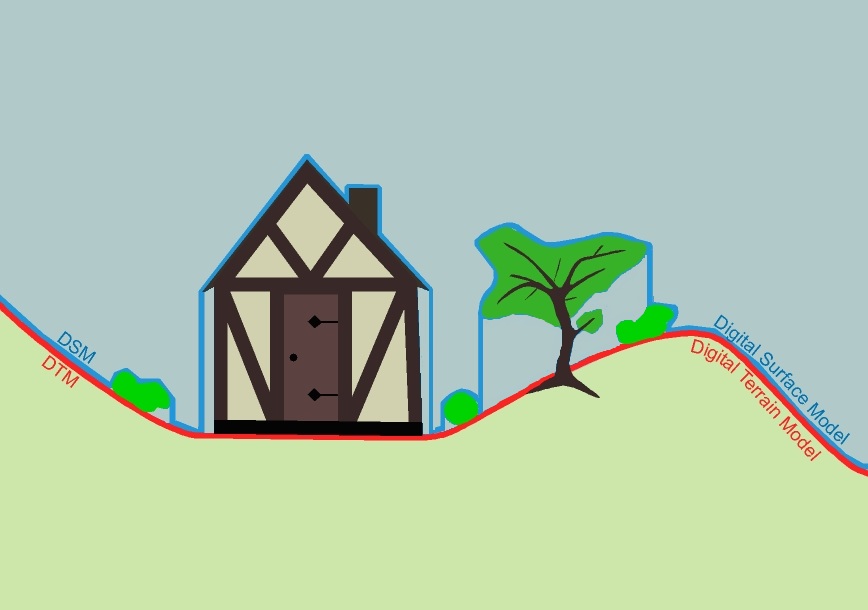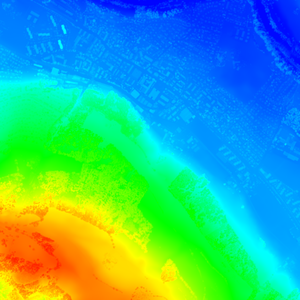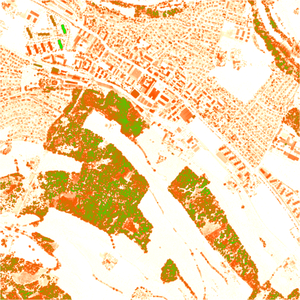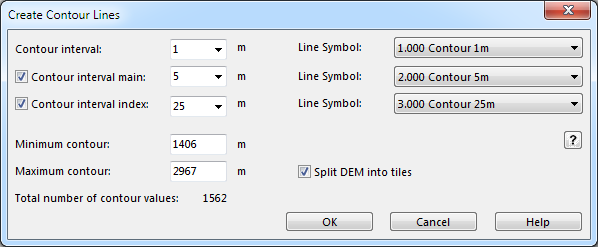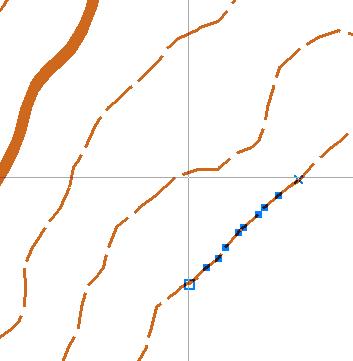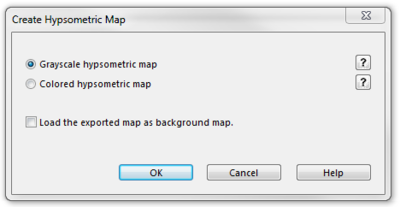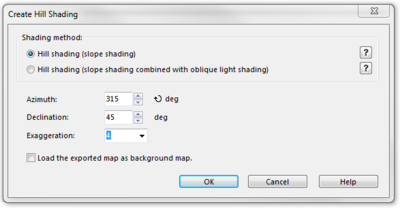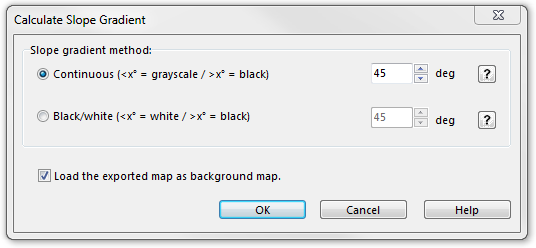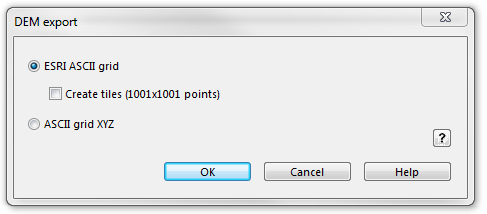DEM
!!! You are not on the Wiki page of the newest OCAD Version. Click here to get there.
This Wiki will not be updated anymore.
A DEM (Digital Elevation Model) contains points with elevation data. DEM Data are based on LIDAR (Light Detection and Ranging) technology measurement, also known as Airborne Laser Scanning. There are DEM with point data arranged in a regular grid with a constant distance between the points. This distance is called cell size. Other DEM contain data points arranged irregularly (cloud-model).
- Read more about this topic: http://en.wikipedia.org/wiki/Digital_elevation_model
Import 


The OCAD DEM Module is able to import files with regular and irregular DEM data. Supported DEM data formats are: ESRI ASCII Grid (*.asc), Raw data ASCII XYZ file (*.xyz), ASCII Grid XYZ file (*.xyz), LAS file (*.las), compressed LAS file (*.laz) and SRTM file (*.hgt) file.
- Open a map or create a new one.
- Select Import from the DEM menu. First use Add button to add at least 1 DEM to the DEM Import dialog.
- Analyze the DEM to get some information about the DEM like extent, cell size etc. The DEM Import dialog extends after analyzing a LAS file and provides some additional settings.
- If the source file is a regular grid (data type of import files = grid), the Cell size box is set to read only. OCAD sets the same cell size for the imported DEM. For irregular DEM data source (data type of import files = raw) the cell size can be set in the 'cell size' box. For these DEM's OCAD interpolates a regular grid with the specified cell size during the import.
- At the end of the import procedure the imported DEM must be saved in the OCAD DEM file format (*.ocdDem) and it is loaded to the OCAD map.
- To see the extent of the loaded DEM activate the Show Frame menu item.
![]() The Cell size range is between 0.01 and 650 m.
The Cell size range is between 0.01 and 650 m.
![]() The DEM import limit depends on the amount of memory available. OCAD can allocate up to 3.5 GB RAM.
The DEM import limit depends on the amount of memory available. OCAD can allocate up to 3.5 GB RAM.
Coordinate System:
DEM data are sometimes in another coordinate system than the map. OCAD provides a new function to transform DEM data during the DEM import.
In this example bellow the map file with the loaded orthophoto has the UTM Zone 18 North coordinate system, but the Lidar data are only available in US State Plane New York Long Island (US Feet).
Click the Choose button in the DEM Import dialog to choose the coordinate system of the DEM file and check the option Convert height values from feet to meters. Click Analyze.
OCAD transforms all data points during the analysis procedure.
LAS data import:
- Click the Choose DTM button to create a terrain model from LAS data. This selects ground classification and the Last return option.
- Click the Choose DSM button to create a surface model from LAS data. This selects all classifications and the First return option.
![]() During LAS data import a classification image and a intensity image are created and loaded as background maps. A difference image between the first and last return is created if the All returns option in the DEM Import dialog is choosen.
During LAS data import a classification image and a intensity image are created and loaded as background maps. A difference image between the first and last return is created if the All returns option in the DEM Import dialog is choosen.
The classification tiff image has the following color index:
- 0 Created, never classified (light gray)
- 1 unclassified (red)
- 2 Ground (yellow)
- 3 Low Vegetation (light green)
- 4 Medium Vegetation (green)
- 5 High Vegetation (dark green)
- 6 Building (Generic) (gray)
- 7 Low point (noise) (gray)
- 9 Water (blue)
- 10 Bridge (brown)
- 11 Road (brown)
- 12 Overlap pointd (gray)
![]() A Radar beam splits as it hits objects. The result are multiple returns. LIDAR can collect up to four returns. The difference between first and last return can show object height. The last return doesn’t always reach the ground.
A Radar beam splits as it hits objects. The result are multiple returns. LIDAR can collect up to four returns. The difference between first and last return can show object height. The last return doesn’t always reach the ground.

- Source: Lohani, Bharat. Airborne Altimetric LiDAR: Principle, Data Collection, Processing and Applications.
![]() Compressed LAS file (*.laz): OCAD uses the laszip.exe tool form Martin Isenburg to decompress the laz file.
Compressed LAS file (*.laz): OCAD uses the laszip.exe tool form Martin Isenburg to decompress the laz file.
SRTM hgt data import:
- This is a world wide available DEM data set from the Shuttle Radar Topography Mission (SRTM).
- The data files and documentation: [1]
![]() SRTM hgt data import requires that a coordinate system set in the OCAD map file.
SRTM hgt data import requires that a coordinate system set in the OCAD map file.
Open 




Open an OCAD DEM file (*ocdDem).
Show Frame 




Shows blue rectangle with the extent of the loaded DEM.
Resize 


Resize the loaded OCAD DEM file (make a subset) and save it as a new OCAD DEM file.
Info 




Shows information about OCAD DEM file.
![]() When moving the mouse cursor over the file name then the file name with path appears.
When moving the mouse cursor over the file name then the file name with path appears.
Close 




Close OCAD DEM file.
Merge DEM 


Choose Merge from DEM menu to merge two different DEMs.
- DEM 1: Choose the first DEM.
- DEM 2: Choose the second DEM.
![]() The two DEMs must have the same cell size.
The two DEMs must have the same cell size.
Calculate DEM Difference 


- Choose Calculate DEM Difference from DEM menu.
- The Calculate DEM Difference dialog box appears.
- Add Upper DEM = DSM data file
- Add Lower DEM = DTM data file
- Click OK.
To visualize the DEM difference choose Classify Vegetation Height
![]() The extent of the Upper DEM and Lower DEM can be different. OCAD takes the overlapping area for the new DEM.
The extent of the Upper DEM and Lower DEM can be different. OCAD takes the overlapping area for the new DEM.
![]() The cell size of Upper DEM and Lower DEM can be different. OCAD takes the cell size of Upper DEM for the new DEM.
The cell size of Upper DEM and Lower DEM can be different. OCAD takes the cell size of Upper DEM for the new DEM.
Example
This is an example to show what can result from the Calculate DEM Difference function.
This is a DTM (Digital Terrain Model) with a cell size of 5m shown as hypsometric map:
The next picture shows the DSM (Digital Surface Model) of the same area with a cell size of 2m as hypsometric map. The buildings (northern part) and forest (south western part) are slightly visible.
The next picture shows a Difference DEM with a cell size of 2m shown as raster background map after calculating the DEM Difference. In addition, heights were colored using the Classify Vegetation Height function.
- The area with no difference of the DTM and the DSM are displayed white.
- A height difference up to 15m appears red.
- The greater the difference, the greener an area appears.
When moving the mouse cursor over the map the difference is shown in the Status Bar.
Data source: Test data Wabern from swisstopo.
Create Contour Lines 


- Choose Create Contour Lines from DEM menu.
- The Create Contour Lines dialog box appears.
This function calculates contour lines based on the loaded DEM.
This function can take a lot of time. OCAD starts to calculate the contour lines from the lowest elevation (minimun contour). During the calculation process the current elevation is shown in the left status bar.
- Define 1-3 contour intervals (for example 1m, 5m, 25m) and a pre-selected line symbol (according to the first three line symbols in the settings) for each type appears (can be changed).
- Specify the minimum (lowest) and maximum (highest) contour for the calculation.
- Activate the option Split DEM into tiles to speed up this calculate process. In this case OCAD splits the dem into small tiles and calculates tile by tile. Finally the contour lines are also splites at the tile borders. It is not visible on the screen but you see it when selecting a contour line. Use the Merge Contour Lines By Selected Symbols function to merge the contour lines if needed.
The selected contour line is cutted at the tile borders.
Create Hypsometric Map 


- This function calculates a grayscale or colored hypsometric map as GeoTIFF file.
- Optionally it is directly loaded as background map.
Two different types of hypsometric maps can be edited:
- Grayscale hypsometric map
- Colored hypsometric map
Create Hill Shading 


- This function calculates a shaded relief picture (hill shading).
- There are two calculation methods available:
- Slope shading is optimized to see outlines of features like paths in a slope.
- Slope shading combined with oblique light shading is the recommended method if the hill shading should be used as a background relief of a map. Optionally the calculated hill shading is directly loaded as background map.
- Aside from the chosen method an Azimuth and a Declination of the light source has to be set. Standard settings are 315° (north-west) and 45°. An Exaggeration factor of 4 is pre-selected and can be altered.
Calculate Slope Gradient 


- Choose Calculate Slope Gradient from DEM menu.
- The Calculate Slope Gradient dialog box appears.
Select one of two different methods:
- Continous (<x° = grayscale / >x° = black)
- Black/White (<x° = white / >x° = black)
The resulting picture can be used to identify cliffs an rock faces. The result can sometimes be significantly improved with a slight adjustment of the gradient (between 42-45 degrees).
Slope gradient also shows paths or relief features independent from a azimut like the Hill Shading.
Classify Vegetation Height 


Choose Classify Vegetation Height from DEM menu. To classify the vegetation height you need first a DEM with the difference from DSM and DTM and load this ocdDem file.
There are two different options to show vegetation height classification:
- Gray scale classification with options: Linear, Quadratic negative, Quadratic positive
- Colored classification: Define classes with a height and color range
- - Split a class into two classes by clicking the Split class button
- - Remove a class by clicking the Remove class button
- - Load the settings from a text file by clicking the Load button
- - Save the settings to a text file by clicking the Save button
- - Reset the classes and colors to the default settings by clicking the Reset classes to default button
Merge Contour Lines By Selected Symbols 


- Select the contour line symbols
- Choose Merge Contour Lines By Selected Symbols from DEM menu.
- The Merge Contour Lines By Selected Symbols dialog box appears.
Create Profile 




Find more information about this function on the DEM Profile page.
Export 


- Choose Export from DEM menu.
- The DEM Export dialog box appears.
The function exports the loaded DEM file as ESRI ASCII Grid or as ASCII Grid XYZ.
Select Create tiles for large DEMs to create tiles fron 1001x1001 points.
Previous Chapter: Printing Maps
Next Chapter: GPS
Back to the Main Page
